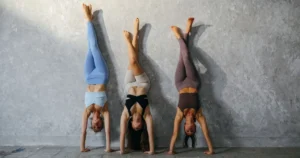Surya Namaskar Steps: A Comprehensive Guide to Practicing Sun Salutation
Surya Namaskar, also known as Sun Salutation, is a popular yoga sequence that combines a series of asanas (postures) with synchronized breathing. This ancient practice holds immense significance in yoga and is revered for its numerous physical and mental health benefits. Whether you’re a beginner or an experienced yogi, understanding the correct Surya Namaskar steps can help you unlock the transformative power of this beautiful practice. In this article, we will delve into the details of each step, providing you with a comprehensive guide to performing Surya Namaskar.
 1.What is Surya Namaskar?
1.What is Surya Namaskar?
Surya Namaskar derives its name from the Sanskrit words “Surya” (Sun) and “Namaskar” (Salutation). It is a dynamic sequence of twelve asanas that are performed in a fluid motion. Each posture in Surya Namaskar is designed to stretch, strengthen, and invigorate different parts of the body, harmonizing the physical, mental, and spiritual aspects of your being.
You may also like..What Type of Yoga is the Best Top 10 Powerful Types
2. Benefits of Surya Namaskar
Surya Namaskar offers a wide array of benefits, making it a complete workout for the body and mind. Some key benefits include:
- Improved flexibility and strength: The various asanas in Surya Namaskar help enhance flexibility and strengthen the muscles.
- Increased energy and vitality: The practice activates and awakens the body, leaving you feeling energized and revitalized.
- Weight loss and maintenance: Surya Namaskar is a great way to burn calories and shed excess weight.
- Stress relief and mental well-being: The mindful movements and focused breathing during Surya Namaskar promote relaxation and reduce stress levels.
- Improved digestion and metabolism: The sequence stimulates the digestive system, aiding in better digestion and metabolism.
- Balance and coordination: Surya Namaskar improves balance and coordination through its flowing movements.
3. Preparing for Surya Namaskar
Before diving into the Surya Namaskar steps, it’s important to prepare your body and mind for the practice. Here are a few essential steps to follow:
- Find a calm and quiet space where you can practice without distractions.
- Wear comfortable clothing that allows freedom of movement.
- Warm up your body with a few gentle stretches to loosen up the muscles.
- Ensure proper hydration by drinking water before and after the practice.
- Start with a few deep, conscious breaths to center yourself and establish a connection with your body.
Surya Namaskar Steps: Embracing the Sun’s Energy
Surya Namaskar is a beautiful and harmonious flow of movements that invigorates the body and energizes the mind. Let’s dive into the detailed steps of this graceful practice:
Step 1: Pranamasana (The Prayer Pose)
Begin by standing at the front edge of your yoga mat with your feet together. Place your palms together in front of your chest in a prayer position. This posture represents gratitude and sets the intention for your practice.
Step 2: Hasta Uttanasana (The Raised Arms Pose)
As you inhale deeply, raise your arms above your head, keeping them shoulder-width apart. Arch your back slightly and gaze gently towards the sky. This movement stretches the entire body and opens up the chest, allowing for deep breaths.
Step 3: Uttanasana (The Standing Forward Bend Pose)
Exhale and slowly bend forward from the hips, bringing your hands down to the mat beside your feet. If needed, you can bend your knees slightly to facilitate the movement. This posture helps to release tension in the hamstrings and allows for a gentle stretch of the spine.
Step 4: Ashwa Sanchalanasana (The Equestrian Pose)
Inhale deeply and step your right leg back into a lunge position, keeping your hands on the mat. Your left knee should be bent at a 90-degree angle, with the left foot positioned between your hands. Look forward and keep your back leg engaged. This pose strengthens the legs and improves flexibility.
Step 5: Dandasana (The Plank Pose)
As you exhale, step your left leg back to join the right leg, coming into a straight-arm plank position. Your body should form a straight line from your head to your heels. Engage your core and hold this pose for a few breaths. Plank pose builds strength in the arms, shoulders, and core muscles.
Step 6: Ashtanga Namaskara (The Eight Limbed Salutation)
Lower your knees, chest, and chin to the mat while keeping your hips lifted. This pose is also known as the Eight Limbed Salutation since eight body parts—hands, knees, chest, and chin—touch the floor. Ashtanga Namaskara strengthens the arms, chest, and shoulders.
Step 7: Bhujangasana (The Cobra Pose)
Slide forward and lift your chest off the mat, keeping your palms on the floor. Straighten your arms as much as possible and lift your gaze towards the ceiling. Bhujangasana stretches the muscles in the shoulders, chest, and abdomen, promoting spinal flexibility.
Step 8: Adho Mukha Svanasana (The Downward Facing Dog Pose)
Push back with your hands, lift your hips up, and form an inverted “V” shape with your body. Press your heels towards the floor while keeping your head relaxed between your arms. This pose stretches the entire body, particularly the hamstrings and calves.
Step 9: Ashwa Sanchalanasana (The Equestrian Pose)
Inhale and step your right foot forward between your hands, returning to the lunge position. Keep your left leg straight and aligned with your body. Look forward and feel the stretch in your hips and thighs.
Step 10: Uttanasana (The Standing Forward Bend Pose)
Exhale and bring your left foot forward to meet the right foot. Allow your upper body to fold over your legs, relaxing your neck and shoulders. Uttanasana helps to calm the mind and relieve stress.
Step 11: Hasta Uttanasana (The Raised Arms Pose)
Inhale deeply as you slowly rise up, sweeping your arms out to the sides and overhead. Arch your back slightly and gaze towards the sky. This posture provides a gentle stretch to the entire body.
Step 12: Pranamasana (The Prayer Pose)
Exhale and return to the starting position, bringing your palms together in front of your chest. Feel the sense of completion and take a moment to reflect on the positive energy generated throughout the practice.
5. Tips for a Fulfilling Surya Namaskar Practice
- Practice on an empty stomach or at least two to three hours after a meal.
- Focus on your breath, inhaling and exhaling deeply with each movement.
- Gradually increase the number of rounds as you become more comfortable.
- Modify the asanas according to your body’s needs and limitations.
- Be consistent and aim for regular practice to experience the full benefits
Conclusion
Surya Namaskar is a transformative yoga practice that not only strengthens and stretches the body but also calms the mind and uplifts the spirit. By following the step-by-step guide provided in this article, you can embark on a fulfilling journey of incorporating Surya Namaskar into your daily routine. Embrace the beauty of this ancient practice and allow the sun salutations to illuminate your path toward holistic well-being.




